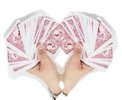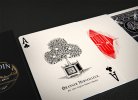My apologies for the back-to-back posting, but I have more ideas to share, and there's a word limit on posts.
As you say, often only the ace of spades is customized, but there’s so much to work with, in terms of magic history, but particularly after I’ve now read up slightly on Robert-Houdin’s life, and I think your four customized aces is clearly the best idea. Certainly just two being customized seems odd. And in my opinion, the more customization the better, as it’s what makes the deck special.
The curtains for the AD are great! It’s very clear that they form a diamond, don’t worry, although it’s a trivial matter to take the left side and mirror image it on the right for perfect symmetry. In addition, having things that *appear* to form the ace shapes, rather than just *being* traditional, enlarged and elaborated suit pips, the curtains again echo the ideas of conjuring and of illusion, as you are conjuring the shapes from something else (curtains; cards; a kerchief, rabbit and hat; an orange tree), and the curtains in particular, with the stage, would give you room for the option, should you choose it, of placing at its center an allusion to one of his most famous tricks. Since his sons were so prominent in his acts, and the tiny son being levitated in the card back corners is not prominent (although good), and yet it deserves more prominence, you could actually put Robert-Houdin levitating his son there, or just the son levitating on one stick (I prefer the former, if it fits), or a son could be blindfolded, sitting in a chair on the stage, as in their secret communication act, although the allusion to the blindfold can be elsewhere, as on one of the jokers or face cards, making the levitation act the best candidate for the stage.
*Definitely* keep the French for the names below the famous tricks; it would be balanced if such names appeared only below the aces and jokers, and nothing else. You are French, no? And French is an integral part of Robert-Houdin’s name and history, having even performed before the French king, and the language is elegant (keeping that theme running); furthermore, some of the French words are familiar enough (le chapeau), and some of us will even get a glimpse of etymological connections to the ones like le lapin that aren’t, if they know the word leporine, or taxonomy (the genus Leporidae), Italian (as in the unfortunate labbro leporino) or Spanish (leporino, labio leporino, liebre) etc.
I particularly like your idea of adding text below the tree naming the trick; I suggest using it with his full name, Jean Eugène Robert-Houdin's Marvelous Orange Tree, perhaps with a line break between his name and the trick's. I suggest adding his given names so that those less informed don't mistake Robert for his given name, but it's totally up to you of course. I like your info card with his portrait, and cannot read the tiny text below it in your image, but again suggest his full name, and that you be sure to add e.g. "Widely known as the father of modern magic" (or "...of modern conjuring") and perhaps his BOB and BOD. Again, just an idea.
Another idea is to add more numerous allusions throughout the deck, at least to the face cards and jokers, e.g., subtly and small, behind the stem of the orange tree, to add two small butterflies, one on either side, each holding the tip of a handkerchief, which drapes behind them and behind the tree's trunk, as they formed an amazing part of that act. And/or a clock (or egg!) in the center of the tree’s base pot. Just an Easter egg (here, literally) for hunters to find. And finally, rather than only generic magical items like saws and wands (which are good), if there is any way to include more references to him somewhere, such as a bit of clockwork mechanics, like a face card that is slightly modified to suggest an automaton writing something (while remaining classical in style, e.g. changing an elbow joint and/or wrist joint to a pair of intermeshed gears), etc.
The three cups is a nice historical link given the engraving and story you shared, and a joker performing it is nice, even a classical joker as you have them, but I’d prefer a non-skull face unless there’s a historical connection between him and a skull. I’ve personally always preferred there to be *some* difference between the two jokers. One could be in color. Or blindfolded. Or both could raise one cup, but different cups, and/or with something different under each cup – an egg (a bit subtle of an allusion, I know), an orange, a gear, a dove just starting to take flight or sitting there, etc. Or, as in the engraving of young Jean-Eugène Robert (without the Houdin, of course, at that age), have one ball atop one cup for one Joker, and the other lifting a cup to reveal an orange or egg or butterfly. Or two cups, revealing both, as they were connected in his orange tree trick. Or several of the above ideas at once. Another Easter egg: the far right and left center edges of the back, at the ends of the horizontal bar, could be butterflies, just outlines to match the rest of the scrolling better.
If you lack four ideas for any of the face cards (I think you said you needed another for a queen), one could be an allusion to the automatons, given their importance, especially the one that wrote and drew. While retaining a classic style, a queen, if you lacked an idea, could have instead of an elbow joint and/or wrist joint, a pair of engaged gears, and be drawing upon on a pad, with the drawing being another allusion – a bit of clockwork etc., a rabbit, the orange tree, etc.
One stronger constructive criticism: I don’t think the cards in a circle look enough like a heart for the ace. It's not just the bottom part that isn't clear; the top is also not symmetrical enough and the hand not rounded enough. That could easily be reworked with symmetry, two hands, each fanning a semicircle of cards, for the top of the heart (far clearer), and the cuffs (with tiny heart-shaped cufflinks and the end of an elegant black sleeve). You might be able to work it so that the corners of the cuffs could touch to form the bottom point of the heart; I was going to sketch it for you but am also busy as père Noël. Again, the combination of other things forming the heart, giving the illusion of a heart, fits the themes of the aces and the art.
A tiny additional allusion to the man and Easter egg would be a wristwatch on the wrist of the hand holding the kerchief above the rabbit/hat ace.
Another detail: you have tiny symbols on the crowns/hats of the royalty but they could be replaced with the suit pip for that particular card. Other than classic style, why have what look like clubs on the crown of the queens and kings of spades and hearts, after all, when that trim could easily be changed to tiny diamonds, clubs, hearts and spades. The classic style would remain, given how subtle the change would be, and yet it would be one more little Easter egg to hide, which could become one of the marvels of this deck – nearly endless Easter eggs.
If you lack ideas for the kings, or decide to move the cage to another card in case you lack an idea for a queen (the king with a cage is nice, but it could as easily be a queen with one, or even a jack, for reasons I explain below), then one idea is to have that king then have some symbols representing King Louis Philippe I, who did rent the theater for a private performance by Robert-Houdin, after all. A glance at a portrait of the king on Wiki, with epaulets and medallions, and/or at his coat of arms should give you ideas on how to link a king more to him. His crown could be restyled slightly to more resemble Philippe I’s, he could hold the orb-topped scepter with the cross, have a bit of ermine fur, the same medallion as at the base of his coat of arms, and/or a fleur-de-lis could be incorporated somewhere – on him, or in the card backs. he could hold a clock or large pocket watch, if needed. Or you could keep each king with your magical object of choice, but give each epaulets and change the symbol at the chest’s top center to a fleur-de-lis or one of his medallions. The one losing the cage to a son/jack could then hold the magical wand, but it could take the form of the orb-topped scepter with the cross from Phillippe I’s coat of arms.

